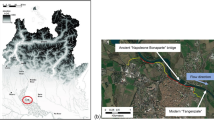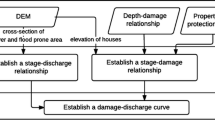Abstract
Flood risk management decisions require the rational assessment of mitigation strategies. This is a complex decision-making process involving many uncertainties. This paper presents a case study where a cost-benefit based methodology is used to define the best intervention measures for flood-risk mitigation in central Spain. Based on different flood hazard scenarios, several structural measures considered by the local Basin Water Authority and others defined by engineering criteria were checked for operability. Non-systematic data derived from dendrogeomorphological analysis of riparian trees were included in the flood frequency analysis. Flood damage was assessed by means of depth-damage functions, and flooded urban areas were obtained by applying a hydraulic model. The best defense strategies were obtained by a cost-benefit procedure, where uncertainties derived from each analytical process were incorporated based on a stochastic approach to estimate expected economic losses. The results showed that large structural solutions are not economically viable when compared with other smaller structural measures, presumably because of the pre-established location of dams in the upper part of the basin which do not laminate the flow generated by the surrounding catchment to Navaluenga.









Similar content being viewed by others
References
Apel H, Thieken AH, Merz B, Blöschl G (2004) Flood risk assessment and associated uncertainty. Nat Hazards Earth Syst Sci 4:295–308
Ayala-Carcedo FJ (2001) Natural disasters mitigation in the world and sustainable development: a risk analysis approach. Bol Geo Min 112(4):43–64
Baker VR (2008) Paleoflood hydrology: origin, progress, prospects. Geomorphology 101:1–13
Ballesteros Cánovas JA, Eguíbar M, Bodoque JM, Díez-Herrero A, Stoffel M, Gutiérrez-Pérez I (2011a) Estimating flash flood discharge in an ungaguged mountan catchment with 2D hydraulic models and dendrogeomorphic paleostage indicators. Hydrol Process 25(6):970–979
Ballesteros Cánovas JA, Bodoque JM, Díez-Herrero A, Sánchez-Silva M, Stoffel M (2011b) Calibration of floodplain roughness and estimation of flood discharge based on tree-ring evidence and hydraulic modeling. J Hydro 403(1–2):103–115
Banco de España (2011) Banco de España Eurosistema. http://www.bde.es/webbde/es/estadis/infoest/tipos/tipos.html. Accessed 1 June 2011
Benito G (2006) Riesgos de inundaciones: tendencias históricas y perspectivas de acuerdo con el cambio climático. Rev Cuater Geo 20(3–4):29–44
Benito G, Thorndycraft VR (2004) Systematic, palaeoflood and historical data for the improvement of flood risk estimation, methodological guidelines. CSIC, Madrid
Benito G, Ouarda TBMJ, Bárdossy A (2005) Applications of palaeoflood hydrology and historical data in flood risk analysis. J Hydro 313(1–2):1–2
CEA (2007) Reducing the social and economic impact of climate change and natural catastrophes-inurance solutions and public-private partnerships. CEA, Brussels
Chang M, Lee R (1974) Objective double mass analysis. Water Resour Res 10(6):1123–1126
Cheng ST, Yen BC, Tang WH (1993) Stochastic risk modeling of dam overtopping. In: Yen BC, Tung YK (eds) Reliability and uncertainty analyses in hydraulic design. ASCE, Reston, pp 123–132
Chow VT (1959) Open-channel Hydraulics. McGraw-Hill, New York
Chow VT, Maidment DR, Mays LW (1988) Applied hydrology. McGraw-Hill, New York
CHT (1992) Plan Hidrológico. Proyecto de Directrices. Condederación Hidrográfica del Tajo, Madrid
CHT (2012) Confederación Hidrográfica del Tajo. http://www.chtajo.es/Informacion%20Ciudadano/Descargas/Paginas/default.aspx. Accessed 5 September 2012
DHI (2008) MIKE 21 flow model. Hydrodinamic module. Scientific Documentation. DHI
Dietrich J, Schumann AH, Redetzky M, Walther J, Denhard M, Wang Y, Pfützner B, Büttner U (2009) Assessing uncertainties in flood forecasts for decision making: prototype of an operational flood management system integrating ensemble predictions. Nat Hazards Earth Syst Sci 9:1529–1540
Díez A (2001) Geomorfología e Hidrología fluvial del río Alberche. Modelos y SIG para la gestión de riberas. Dissertation. Universidad Complutense de Madrid.
Díez-Herrero A, Laín-Huerta L, Llorente-Isidro MA (2009) Handbook on flood hazard mapping methodologies. Spain Geological Survey, Madrid
Dutta D, Herath S, Musiake K (2006) An application of a flood risk analysis system for impact analysis of a flood control plan in a river basin. Hydrol Process 20:1365–1384
Eum HI, Vasan A, Simonovic SP (2012) Integrated reservoir management system for flood risk assessment under climate change. Water Resour Manage 26(13):3785–3802
Faber R (2006) Flood risk analysis: Residual risks and uncertainties in an Austrian context. Dissertation. University of Natural Resources and Applied Life Sciences
Ferrer M, González Vallejo L, García López-Davalillo JC, Rodíguez Franco JA (2004) Pérdidas por Terremotos e inundaciones en España durante el periodo 1987–2001 y su estimación para los próximos 30 años (2004–2033). Consorcio Compensación de Seguros, Madrid
Gaume E, Bain V, Bernardara P et al (2009) A compilation of data on European flash floods. J Hydro 367(1–2):70–78
GTAGU (2010) Precio Centro 2010 Aparejadores Guadalajara, S.L.U. http://www.coaatgu.com/gtagu/. Accessed 12 May 2010
Heidari A (2009) Structural master plan of flood mitigation measures. Nat Hazards Earth Syst Sci 9:61–75
HSE (2001) Reducing risks, protecting people. HSE’s decision-making process. Health and Safety Executive, Suffolk
Huberlandt U, von Eschenbach ADE, Buchwald I (2008) A space-time hybrid hourly rainfall model for derived flood frequency analysis. Hydrol Earth Syst Sci 12(6):1353–1367
IPCC, Climate Change (2001) Impacts, adaptation and vulnerability. In: McCarthy JJ, Canziani OF, Leary NA, Dokken DJ, White KS (eds) Contribution of working group II to the third assessment report of IPCC. Cambridge University Press, Cambridge
Jonkman SN (2007) Loss of life estimation in flood risk assessment. Theory and applications. Dissertation. Technische Universiteit Delft
Kang J-L, Su M-D, Chang L-F (2005) Loss functions and framework for regional flood damage estimation in residential area. J Mar Sci Technol 13(3):193–199
Kohler MA (1949) Double-mass analysis for testing the consistency of records and for making required adjustments. B Am Meteorol Soc 30:188–189
Loucks DP, Stedinger JR, DaArryl WD, Stakhiv EZ (2008) Private and public responses to flood risks. Int J Water Resour D24(4):541–553
Merz B, Thieken A, Blöschl G (2002) Uncertainty analysis for flood risk estimation, Intern. Commission for the Hydrology of the Rhine basin, Proc. Intern. Conf. on Flood Estimation, Berne, CHR Report II-17 pp 577–585
Merz B, Hall J, Disse M, Schumann A (2010) Fluvial flood risk management in a changing world. Nat Hazards Earth Syst Sci 10:509–527
MMA (2008) Información a cerca del Inventario de Presas con información cartográfica. Ministerio de Medioambiente de España http://www.mma.es/portal/secciones/acm/aguas_continent_zonas_asoc/seguridad_resas/inventario_presas/consulta_inventario.htm. Accessed 12 December 2009
Neuhold C, Stanzel P, Nachtnebel HP (2009) Incorporating river morphological changes to flood risk assessment: uncertainties, methodology and application. Nat Hazards Earth Syst Sci 9:789–799
Orejana D, Villaseca C, Perez-Soba C, López-García JA, Billström K (2009) The Variscan gabbros from the Spanish Central System: a case for crustal recycling in the sub-continental lithospheric mantle? Lithos 110(1–4):262–276
Pall P, Aina T, Stone DA, Stott PA, Nozawa T, Hilberts AMG, Lohmann D, Myles RA (2011) Anthropogenic greenhouse gas contribution to flood risk in England and Wales in autumn 2000. Nature 470:382–385
PATRICOVA (2002) Plan de acción territorial de carácter sectorial sobre prevención del riesgo de inundación en la comunidad valenciana. Documento Nº 1.Dirección General de Urbanismo y Ordenación Territorial, Generalitat Valenciana, Valencia
Plate, EJ (2000) Stochastic hydraulic design—Has its time come?. In: Wang Z-Y, Hu S-X. (eds.), Stochastic Hydraulics 2000, Proceedings of the Eighth IAHR Conference on Stochastic Hydraulics, Beijing, Balkema, Rotterdam, pp 3–14
Plate EJ (2002) Flood risk and flood managment. J Hydrol 267:2–11
Rackwitz R, Lentz A, Faber M (2005) Socio-economically sustainable civil engineering infrastructures by optimization. Struct Saf 27:187–229
Rasekh A, Afshar A, Afshar MH (2010) Risk-cost optimization of hydraulic structures: methodology and case study. Water Resour Manag 24(11):2833–2851
Rodrigues AS, Santos MA, Santos AD, Rocha F (2002) Dam-break flood emergency management system. Water Resour Manag 16(6):489–503
Sánchez-Silva M (2001) Basic concepts on risk analysis and the decision making process. Int J Civil Eng Environ Syst 18:225–277
Searcy JK, Hardison CH (1960) Double-mass curves, Manual of hydrology: Part 1. General surface water techniques. United States Government Printing Office, Washington, pp 31–66
Tung T-K (2002) Risk-based design of flood defense systems. In: Wu Y et al (eds) Flood Defence. Scence Press, New York, pp 71–81
Tung YK, Mays LW (1981) Optimal risk-based design of flood levee system. Water Resour Res 17(4):843–852
U.S. Army Corp of Engineers (USACE) (1992) Catalog of residential depth-damage function. IWR Report 92-R-3. Belovoir
U.S. Army Corp of Engineers (USACE) (2009) Hydrologic modelling system HEC-HMS, user’s manual. Version 3.4, U.S. Davis, California
Yong KS-K (2005) A numerical model of sediment-laden turbulent flow in an open channel. Can J Civil Eng 32:233–240
Zhu T, Lund JR (2009) Up or Out?-Economic-engineering theory of flood levee height and setback. J Water Res Pla-ASCE 135(2):90–95
Acknowledgments
This work has been funded by the MAS Dendro-Avenidas project (CGL2010-19274), MAPFRE foundation and the Geological Survey of Spain (IGME). The authors would like to thank the local authorities of Navaluenga for their collaboration, as well as the anonymous reviewer, who have improved significantly this paper.
Author information
Authors and Affiliations
Corresponding author
Rights and permissions
About this article
Cite this article
Ballesteros-Cánovas, J.A., Sanchez-Silva, M., Bodoque, J.M. et al. An Integrated Approach to Flood Risk Management: A Case Study of Navaluenga (Central Spain). Water Resour Manage 27, 3051–3069 (2013). https://doi.org/10.1007/s11269-013-0332-1
Received:
Accepted:
Published:
Issue Date:
DOI: https://doi.org/10.1007/s11269-013-0332-1




